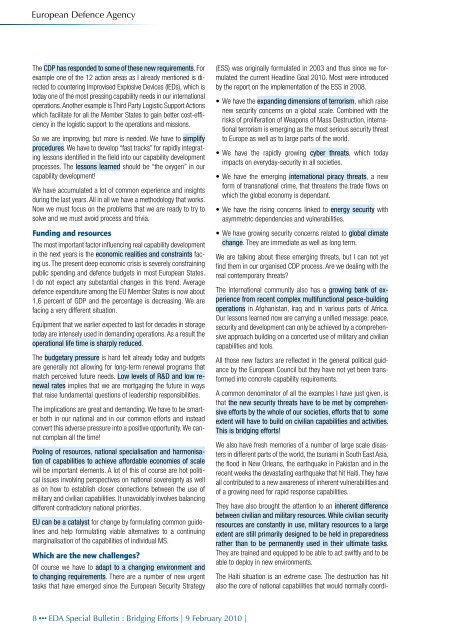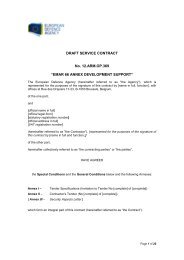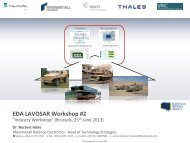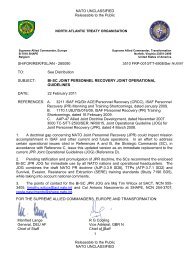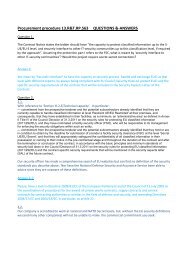Bulletin 14 - "Bridging Efforts" Special Bulletin - European Defence ...
Bulletin 14 - "Bridging Efforts" Special Bulletin - European Defence ...
Bulletin 14 - "Bridging Efforts" Special Bulletin - European Defence ...
You also want an ePaper? Increase the reach of your titles
YUMPU automatically turns print PDFs into web optimized ePapers that Google loves.
The CDP has responded to some of these new requirements. For<br />
example one of the 12 action areas as I already mentioned is directed<br />
to countering Improvised Explosive Devices (IEDs), which is<br />
today one of the most pressing capability needs in our international<br />
operations. Another example is Third Party Logistic Support Actions<br />
which facilitate for all the Member States to gain better cost-efficiency<br />
in the logistic support to the operations and missions.<br />
So we are improving, but more is needed. We have to simplify<br />
procedures. We have to develop “fast tracks” for rapidly integrating<br />
lessons identified in the field into our capability development<br />
processes. The lessons learned should be “the oxygen” in our<br />
capability development!<br />
We have accumulated a lot of common experience and insights<br />
during the last years. All in all we have a methodology that works.<br />
Now we must focus on the problems that we are ready to try to<br />
solve and we must avoid process and trivia.<br />
Funding and resources<br />
The most important factor influencing real capability development<br />
in the next years is the economic realities and constraints facing<br />
us. The present deep economic crisis is severely constraining<br />
public spending and defence budgets in most <strong>European</strong> States.<br />
I do not expect any substantial changes in this trend. Average<br />
defence expenditure among the EU Member States is now about<br />
1,6 percent of GDP and the percentage is decreasing. We are<br />
facing a very different situation.<br />
Equipment that we earlier expected to last for decades in storage<br />
today are intensely used in demanding operations. As a result the<br />
operational life time is sharply reduced.<br />
The budgetary pressure is hard felt already today and budgets<br />
are generally not allowing for long-term renewal programs that<br />
match perceived future needs. Low levels of R&D and low renewal<br />
rates implies that we are mortgaging the future in ways<br />
that raise fundamental questions of leadership responsibilities.<br />
The implications are great and demanding. We have to be smarter<br />
both in our national and in our common efforts and instead<br />
convert this adverse pressure into a positive opportunity. We cannot<br />
complain all the time!<br />
Pooling of resources, national specialisation and harmonisation<br />
of capabilities to achieve affordable economies of scale<br />
will be important elements. A lot of this of course are hot political<br />
issues involving perspectives on national sovereignty as well<br />
as on how to establish closer connections between the use of<br />
military and civilian capabilities. It unavoidably involves balancing<br />
different contradictory national priorities.<br />
EU can be a catalyst for change by formulating common guidelines<br />
and help formulating viable alternatives to a continuing<br />
marginalisation of the capabilities of individual MS.<br />
Which are the new challenges?<br />
Of course we have to adapt to a changing environment and<br />
to changing requirements. There are a number of new urgent<br />
tasks that have emerged since the <strong>European</strong> Security Strategy<br />
(ESS) was originally formulated in 2003 and thus since we formulated<br />
the current Headline Goal 2010. Most were introduced<br />
by the report on the implementation of the ESS in 2008.<br />
• We have the expanding dimensions of terrorism, which raise<br />
new security concerns on a global scale. Combined with the<br />
risks of proliferation of Weapons of Mass Destruction, international<br />
terrorism is emerging as the most serious security threat<br />
to Europe as well as to large parts of the world.<br />
• We have the rapidly growing cyber threats, which today<br />
impacts on everyday-security in all societies.<br />
• We have the emerging international piracy threats, a new<br />
form of transnational crime, that threatens the trade flows on<br />
which the global economy is dependant.<br />
• We have the rising concerns linked to energy security with<br />
asymmetric dependencies and vulnerabilities.<br />
• We have growing security concerns related to global climate<br />
change. They are immediate as well as long term.<br />
We are talking about these emerging threats, but I can not yet<br />
find them in our organised CDP process. Are we dealing with the<br />
real contemporary threats?<br />
The international community also has a growing bank of experience<br />
from recent complex multifunctional peace-building<br />
operations in Afghanistan, Iraq and in various parts of Africa.<br />
Our lessons learned now are carrying a unified message: peace,<br />
security and development can only be achieved by a comprehensive<br />
approach building on a concerted use of military and civilian<br />
capabilities and tools.<br />
All those new factors are reflected in the general political guidance<br />
by the <strong>European</strong> Council but they have not yet been transformed<br />
into concrete capability requirements.<br />
A common denominator of all the examples I have just given, is<br />
that the new security threats have to be met by comprehensive<br />
efforts by the whole of our societies, efforts that to some<br />
extent will have to build on civilian capabilities and activities.<br />
This is bridging efforts!<br />
We also have fresh memories of a number of large scale disasters<br />
in different parts of the world, the tsunami in South East Asia,<br />
the flood in New Orleans, the earthquake in Pakistan and in the<br />
recent weeks the devastating earthquake that hit Haiti. They have<br />
all contributed to a new awareness of inherent vulnerabilities and<br />
of a growing need for rapid response capabilities.<br />
They have also brought the attention to an inherent difference<br />
between civilian and military resources. While civilian security<br />
resources are constantly in use, military resources to a large<br />
extent are still primarily designed to be held in preparedness<br />
rather than to be permanently used in their ultimate tasks.<br />
They are trained and equipped to be able to act swiftly and to be<br />
able to deploy in new environments.<br />
The Haiti situation is an extreme case. The destruction has hit<br />
also the core of national capabilities that would normally coordi-<br />
8 EDA <strong>Special</strong> <strong>Bulletin</strong> : <strong>Bridging</strong> Efforts | 9 February 2010 |


